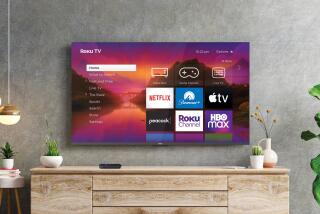TV maker Vizio rising fast in electronic peripherals
- Share via
In just under eight years, Vizio Inc. has gone from a no-name brand to the nation’s top seller of LCD televisions.
Now the Irvine company has set its sights on becoming the largest consumer electronics company as it quietly rolls out such home entertainment gadgets as speakers, Blu-ray players, headphones and even Internet routers.
FOR THE RECORD:
Vizio: An article in the Dec. 25 Business section about TV maker Vizio Inc.’s branching into other types of consumer electronics said that most of the company’s 300 employees work in sales. In fact, most of Vizio’s employees work in tech support and customer service. —
“When we first started the company, we weren’t even a tier-three brand. We were a tier I-don’t-know-what brand,” said Laynie Allen Newsome, Vizio’s co-founder and vice president of sales. “But the idea has always been to build a consumer electronics brand.... We didn’t start Vizio just to make TVs.”
So far, television has been its bread and butter. Since 2002, Vizio has sold more than 30 million TVs and recently toppled Samsung Electronics Co. for the top spot in LCD television shipments in the U.S.
“I remember, even three years ago, people would joke about the Vizio brand,” said James McQuivey, a consumer electronics analyst at Forrester Research Inc. “People really discounted them. And now we look up at them and their trading spots with Samsung as the top TV maker in North America month after month.”
Its entry into gadgets and electronics accessories is quickly gaining traction.
Since Vizio began selling a line of sound bars — thin speakers that are attached to TVs and emulate surround-sound speaker systems — it has captured about half the U.S. market in a little over a year, according to the Consumer Electronics Assn.
Sales of Vizio’s Blu-ray players, which began in July 2009, were up more than 400% in November from the same month last year, Newsome said.
In August, the company rolled out an Internet router. Its home-theater headphones, which connect to the company’s higher-end TVs and sound bars, are expected to hit store shelves in mid-January.
The privately held company declined to break out the numbers for each non-TV item it has sold, but Newsome said the firm has shipped 3.5 million non-TV products this year, up from 900,000 in 2009. Vizio had overall sales of $2.5 billion in 2009 and expects $3 billion this year.
It is following the same business model for its electronics accessories that it has used for TVs, Newsome said.
The company, for instance, does not manufacture TV sets or any of the gadgets. Instead, it partners with low-cost manufacturers in China and ships the products directly to retailers such as Wal-Mart, Target, Sam’s Club and Costco.
Vizio has about 300 employees, most of whom work in sales, and it spends little on advertising, she said.
Randy Lawson, an analyst at research firm ISuppli Corp., said Vizio’s move into non-TV products doesn’t pose much of a risk for the company because all the products are related to the television set.
“This is low-hanging fruit for Vizio,” Lawson said. “Everything they sell has Wi-Fi connectivity, so they make an Internet router. TVs are getting thinner, and so sound bars are becoming more important. It all makes sense.”
Getting into TV peripherals may make sense, but it won’t spur the kind of growth in revenue that Vizio has enjoyed, McQuivey said. That’s because the products, which are significantly lower in price than television sets, have smaller profit margins.
If Vizio wants to be held in the same esteem as consumer tech giants such as Samsung and Sony Corp., he said, it needs to do something bigger than speakers and accessories.
“If they have what it takes, if Vizio has the courage that they’ve demonstrated at their launch getting into the TV business, I would think they’d get into the tablet space,” McQuivey said.
“Vizio got into the TV business at an explosive time, exactly the right time, as everyone was upgrading to flat-panel TVs,” he said. “The only thing I see that’s as explosive right now as TVs were when Vizio got started is tablets. But they have to do it about now. If they wait a year, it will be too late.”
Newsome and others at Vizio offered few details on what other types of electronics might be coming next year.
“We’re still a very young company when it comes to beyond TV,” said Tony Grasso, Vizio’s senior director of business development.
“When we were looking at the sound bar market and figuring out whether or not we wanted to enter it,” Grasso said, “it made sense because there were a few really high-end choices and then a bunch of junk, but nothing with decent quality at a mid-range price.
“We could make a $1,000 sound system for about $200 or $300. Those are the sorts of moves we’re trying to make, and we’re making them carefully.”
nathan.olivarezgiles@latimes.com
More to Read
Inside the business of entertainment
The Wide Shot brings you news, analysis and insights on everything from streaming wars to production — and what it all means for the future.
You may occasionally receive promotional content from the Los Angeles Times.










